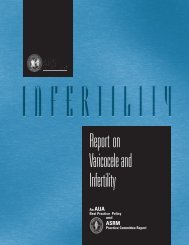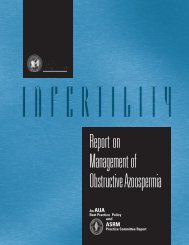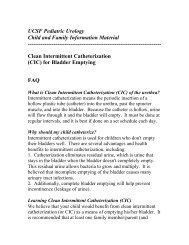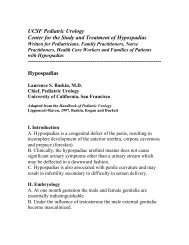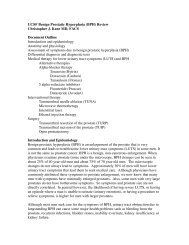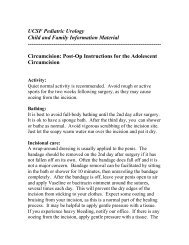Pyeloplasty Surgery for Uretero-Pelvic Junction (UPJ) Obstruction
Pyeloplasty Surgery for Uretero-Pelvic Junction (UPJ) Obstruction
Pyeloplasty Surgery for Uretero-Pelvic Junction (UPJ) Obstruction
Create successful ePaper yourself
Turn your PDF publications into a flip-book with our unique Google optimized e-Paper software.
UCSF Pediatric Urology<br />
Child and Family In<strong>for</strong>mation Material<br />
------------------------------------------------------------------------<br />
<strong>Pyeloplasty</strong> <strong>Surgery</strong> <strong>for</strong> <strong>Uretero</strong>-<strong>Pelvic</strong> <strong>Junction</strong> (<strong>UPJ</strong>)<br />
<strong>Obstruction</strong><br />
What is pyeloplasty surgery?<br />
The surgical reconstruction or revision of the renal pelvis in order<br />
to drain and decompress the kidney. In nearly all cases, the goal of<br />
the pyeloplasty surgery will be to relieve a <strong>UPJ</strong> (uretero-pelvic<br />
junction) obstruction.<br />
Why does my child need the pyeloplasty surgery?<br />
A blockage at the connection of the kidney (renal pelvis) with the<br />
ureter (tube that carries urine from the kidneys to the bladder) has<br />
been detected. This is referred to as a <strong>UPJ</strong> (uretero-pelvic<br />
junction) obstruction. This narrowing causes a ballooning<br />
out/dilation of the kidney known as hydronephrosis. Usually this<br />
can be verified by an ultrasound and kidney scan.<br />
What causes the <strong>UPJ</strong> obstruction?<br />
We do not know exactly. There is much research being done to<br />
help understand more about what causes <strong>UPJ</strong> obstruction, but at<br />
this time we believe it is caused by an abnormal connection<br />
between the kidney and the ureter. This results in a kink and other<br />
de<strong>for</strong>mities that make the situation worse.<br />
Are any artificial parts used in the pyeloplasty surgery?<br />
No. The original ureter is surgically approached below the level of<br />
the obstruction and the abnormal section is removed. Then the<br />
ureter is repositioned and reattached to the healthy renal pelvic<br />
tissue above.
Where is the incision?<br />
The surgery can be done from a few different angles. In general,<br />
the incision will be on your child's side. Your surgeon will discuss<br />
the location of the incision that is the most appropriate <strong>for</strong> your<br />
child. All sutures are dissolvable and do not need to be removed.<br />
Occasionally there will be one skin suture removed 10 days or so<br />
after the operation if a drain left in place.<br />
Are any tubes left in place after the surgery?<br />
Different surgeons use different approaches. For example, a<br />
"stent" may be left in place to drain the ureter (<strong>for</strong> about 7 to 10<br />
days) and a nephrostomy (kidney catheter) <strong>for</strong> about 10 to 12<br />
days. A small drain (made of special, soft rubber), called a<br />
penrose drain, may be left under the incision. The tube/drains are<br />
removed in the office with minimal, brief discom<strong>for</strong>t. This is<br />
usually not painful, but may feel a bit strange. In some cases, no<br />
tubes will be left in place. Occasionally, a small amount of<br />
reddish-brown drainage may come out of the tubes/drains. It is<br />
also to be expected that the skin around the tubes/drains reddens<br />
and may have pus-like secretions around it. This is nothing to be<br />
alarmed about and is a natural reaction to the drain. Be<strong>for</strong>e you<br />
take your child home, we will help you feel com<strong>for</strong>table assessing<br />
the tube and taking care of it at home. If no drain is left in place,<br />
then the post-operative visit should be scheduled <strong>for</strong> two to four<br />
weeks after surgery.<br />
While your child is in the hospital, she/he will have a catheter in<br />
the bladder to assure that bladder and kidney are not stressed.<br />
While the catheter is in the bladder, your child may experience<br />
bladder spasms (intermittent cramping). If this occurs, your<br />
surgeon will prescribe a medication called Ditropan that will<br />
provide relief. The catheter will be removed be<strong>for</strong>e your child<br />
goes home.<br />
How long will the surgery take?
The surgery takes approximately 2 to 3 hours. If it takes a little bit<br />
longer or shorter, do not be alarmed. The operating room nurse,<br />
who you will meet on the day of surgery, will give your family<br />
periodic updates on the status of the surgery.<br />
Can I stay with my child in the hospital?<br />
Absolutely! We encourage parents to stay with their child in the<br />
room. The nurses on the floor will help to make you com<strong>for</strong>table.<br />
We also encourage siblings to visit during the day as long as they<br />
don't have a cold.<br />
What can I expect post-operatively?<br />
While in the hospital, your child will receive medication as needed<br />
<strong>for</strong> pain. Towards the end of the procedure, your child may be<br />
given a caudal or epidural nerve block which will help bridge the<br />
gap of pain between the time your child is in the operating room<br />
and when he/she wakes up. The epidural catheter usually remains<br />
in place <strong>for</strong> about 48 hours. Sometimes with infants, caudal<br />
morphine is used and then they are switched to oral pain<br />
medication. Younger children will be given pain medication<br />
(usually morphine) intravenously be<strong>for</strong>e the caudal wears off<br />
completely. Some older children are candidates <strong>for</strong> PCA (Patient<br />
Controlled Analgesia) pumps. This involves infusion of the pain<br />
medication through the IV to maintain a more consistent blood<br />
level of pain medication. Please discuss with the anesthesiologist,<br />
whom you will meet the day of surgery, what is the best <strong>for</strong>m of<br />
pain control <strong>for</strong> your child.<br />
A prescription <strong>for</strong> pain medication that can be taken by mouth<br />
(usually Tylenol with Codeine) will be given to you at the time of<br />
discharge. You can have the prescription filled at any pharmacy<br />
that is convenient <strong>for</strong> you.<br />
Will my child have any problems urinating after surgery?
After having had a bladder catheter, it is common to experience<br />
urinary frequency and maybe some discom<strong>for</strong>t <strong>for</strong> the first few<br />
times your child tries to urinate. Sitting the child in a shallow tub<br />
of warm water may provide relief. Also placing a damp, warm<br />
washcloth on the perineum may make the child more com<strong>for</strong>table.<br />
What kind of side effects do the medications have?<br />
Many children often lack interest in food following surgery.<br />
However, we ask that you continue to offer your child frequent<br />
fluids to maintain an adequate urine output. He/she does not have<br />
to take a large amount at one time, even just a few sips every 15<br />
minutes or so is great. Be creative with the way you offer liquids.<br />
If your child enjoys popsicles, jello or soup, offer these first <strong>for</strong><br />
meals. Smoothies (yogurt and fruit) are a terrific source of<br />
vitamins and are usually tolerated well. This may require patience<br />
and persistence on your part as you offer fluids (in one <strong>for</strong>m or<br />
another) frequently.<br />
Morphine, Droperidol or Demerol are among the medications your<br />
child may be given while in the hospital. These medications<br />
should help the discom<strong>for</strong>t, but may make your child drowsy.<br />
Although it is rare, it is important <strong>for</strong> you to know that some<br />
children react to pain medication differently. Some children<br />
become overexcited, nervous or develop a rash. If this happens,<br />
simply let the nurse taking care of your child know and the<br />
medication will be changed to amore agreeable one <strong>for</strong> your child.<br />
Be<strong>for</strong>e discharge, the medication will be switched to Tylenol with<br />
codeine (Tyco). This comes in both tablet and liquid <strong>for</strong>m. The<br />
codeine part of this medication can make some children<br />
constipated, so it is particularly important to encourage your child<br />
to be as active as possible. Provide plenty of liquids, fruits and<br />
vegetables when tolerated. Smoothies are a terrific source of<br />
vitamins and are usually tolerated well. Gradually, you can start to<br />
manage your child's discom<strong>for</strong>t with plain Tylenol as needed.
Within a few days to a week after discharge, you should begin to<br />
notice your child fleeing more like him or herself again.<br />
What is the follow-up after surgery?<br />
Your child will usually be discharged on the second or third day<br />
after surgery. If a drain or catheter is left in place, an office<br />
appointment should be made <strong>for</strong> one week after surgery to remove<br />
it. If there is no drain, schedule an appointment <strong>for</strong> four weeks<br />
after the surgery. It is important that your child continue the lowdose<br />
antibiotics until this time.<br />
One to two months after the surgery, your child will be scheduled<br />
<strong>for</strong> an ultrasound of the kidneys. This test tells us if there is any<br />
blockage at the site of the surgery. Some surgeons may<br />
recommend repeating a renal scan to tell us about kidney function.<br />
Your child should then visit us <strong>for</strong> a follow-up in 6 to 8 months <strong>for</strong><br />
another ultrasound and office visit.<br />
Children who have undergone successful pyeloplasty surgery may<br />
still get urinary tract infections. If you suspect your child has an<br />
infection, you should notify your child's pediatrician, or us at our<br />
office: 415 353 2200.<br />
Please contact our office (415 353 2200) if you are concerned with<br />
your child's progress after surgery, or if your child exhibits any of<br />
the following:<br />
• Temperature greater than 101° F<br />
• Excessive bleeding<br />
• Extreme irritability/inconsolability<br />
• Difficulty urinating<br />
• Vomiting<br />
• Return of symptoms experienced prior to procedure




